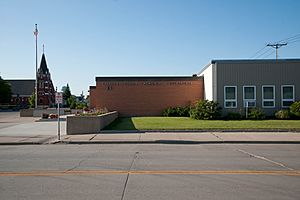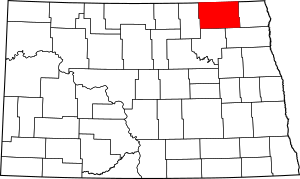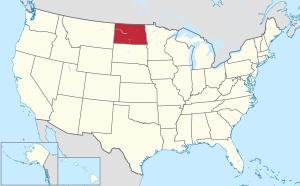Cavalier County, North Dakota facts for kids
Quick facts for kids
Cavalier County
|
|
|---|---|

Cavalier County Courthouse
|
|

Location within the U.S. state of North Dakota
|
|
 North Dakota's location within the U.S. |
|
| Country | |
| State | |
| Founded | 1873 (created) 1884 (organized) |
| Named for | Fur trapper and explorer Charles Cavalier |
| Seat | Langdon |
| Largest city | Langdon |
| Area | |
| • Total | 1,510 sq mi (3,900 km2) |
| • Land | 1,489 sq mi (3,860 km2) |
| • Water | 21 sq mi (50 km2) 1.4% |
| Population
(2020)
|
|
| • Total | 3,704 |
| • Estimate
(2022)
|
3,597 |
| • Density | 2.453/sq mi (0.947/km2) |
| Time zone | UTC−6 (Central) |
| • Summer (DST) | UTC−5 (CDT) |
| Congressional district | At-large |
Cavalier County is a county in the state of North Dakota, United States. It is located just south of the border with Manitoba, Canada. In 2020, about 3,704 people lived here. The main town and county seat is Langdon.
You might think the city of Cavalier is in this county, but it's actually in Pembina County nearby.
Contents
History of Cavalier County
Cavalier County was first created on January 4, 1873. This happened when the government of the Dakota Territory decided to use land from Pembina County. However, the county government didn't start working right away.
The county was named after Charles Cavileer (or Cavalier). He was an early settler and fur trapper from Pembina.
How the County Government Started
The county officially started its government on July 8, 1884. Its borders changed a bit in 1883 and again in 1887.
After asking the Governor of the Dakota Territory for permission, a few people met to set up the county. On July 26, 1884, the first county officials met. They chose L.C. Noracong as the chairman. They also picked the first Register of Deeds, County Clerk, Judge, School Superintendent, and Sheriff.
In 1887, the county grew bigger. More land was added from Pembina County, making Cavalier County its current size. This added 15 new areas called townships.
Choosing the County Seat
The county officials chose a main town for the county at their second meeting. They named it Langdon. This name honored Robert Bruce Langdon from Minnesota. He was an important person with the Great Northern Railroad. It's said that Langdon never visited the town. But he did give a bell for the local school.
Courthouse Buildings
The first courthouse was built in 1884. It cost $360.00. It was used only for a short time. Then, officials moved to a warmer spot in a downtown bank.
A larger brick courthouse was built in 1895. It cost $9,099.00. This building served the county until the current courthouse was built. The newest one was finished in 1957–58.
Cavalier County Historical Society
The Cavalier County Historical Society was started after 1969. The Holy Trinity Church in Dresden, North Dakota, became the main part of the county museum. It now holds many old items and important landmarks from the area.
The Holy Trinity Church in Dresden was built in 1936. It replaced two older wooden churches that had burned down. This church was made from fieldstones. Local church members collected these stones themselves. An architect named Fabian Redmond designed the building. A stonemason, Edroy Patterson, led the volunteer workers.
Geography of Cavalier County
Cavalier County is located in the northern part of North Dakota. Its northern border touches the country of Canada. The Pembina River flows into the county from Manitoba. It then moves southeast through the eastern part of the county.
The county has rolling hills. The western part has many lakes and ponds. The land generally slopes down towards the east. The highest point is about 1,644 feet (501 meters) above sea level. The county covers a total area of 1,510 square miles (3,910 square kilometers). About 1,489 square miles (3,856 square kilometers) is land, and 21 square miles (54 square kilometers) is water.
Major Highways
Neighboring Areas
- Municipality of Louise, Manitoba (north)
- Municipality of Pembina, Manitoba (north)
- Rural Municipality of Stanley, Manitoba (north)
- Pembina County (east)
- Walsh County (southeast)
- Ramsey County (south)
- Towner County (west)
Lakes
- Rush Lake
People in Cavalier County (Demographics)
| Historical population | |||
|---|---|---|---|
| Census | Pop. | %± | |
| 1890 | 6,471 | — | |
| 1900 | 12,580 | 94.4% | |
| 1910 | 15,659 | 24.5% | |
| 1920 | 15,555 | −0.7% | |
| 1930 | 14,554 | −6.4% | |
| 1940 | 13,923 | −4.3% | |
| 1950 | 11,840 | −15.0% | |
| 1960 | 10,064 | −15.0% | |
| 1970 | 8,213 | −18.4% | |
| 1980 | 7,636 | −7.0% | |
| 1990 | 6,064 | −20.6% | |
| 2000 | 4,831 | −20.3% | |
| 2010 | 3,993 | −17.3% | |
| 2020 | 3,704 | −7.2% | |
| 2022 (est.) | 3,597 | −9.9% | |
| U.S. Decennial Census 1790-1960 1900-1990 1990-2000 2010-2020 |
|||
2020 Census Information
According to the census in 2020, there were 3,704 people living in Cavalier County.
2010 Census Information
In 2010, the county had 3,993 people. There were 1,818 households and 1,142 families. The population density was about 2.7 people per square mile. Most people (97.7%) were white. About 0.9% were American Indian.
Many people in the county had German (44.5%) and Norwegian (28.8%) backgrounds. Other ancestries included American, Irish, Swedish, and English.
The average age of people in the county was 50.3 years old. The median income for a household was $48,786. This means half of the households earned more than this, and half earned less. About 8.2% of the population lived below the poverty line.
Population Over Time

Towns and Communities
Cavalier County has several towns and smaller communities.
Cities
Unincorporated Communities
These are smaller places without their own city government.
Townships
Townships are smaller local areas within the county.
- Alma
- Banner
- Billings
- Bruce
- Byron
- Cypress
- Dresden
- Easby
- East Alma
- Elgin
- Fremont
- Glenila
- Gordon
- Grey
- Harvey
- Hay
- Henderson
- Hope
- Huron
- Langdon
- Linden
- Loam
- Manilla
- Minto
- Montrose
- Moscow
- Mount Carmel
- Nekoma
- North Loma
- North Olga
- Osford
- Osnabrock
- Perry
- Seivert
- South Dresden
- South Olga
- Storlie
- Trier
- Waterloo
- West Hope
See also
 In Spanish: Condado de Cavalier para niños
In Spanish: Condado de Cavalier para niños

